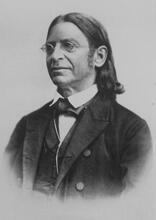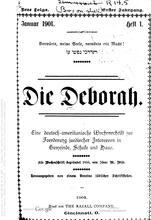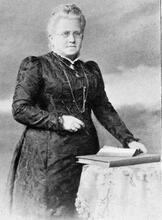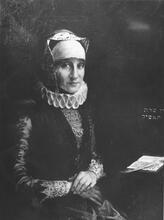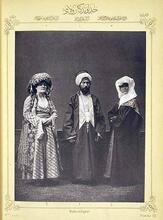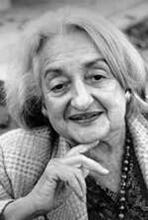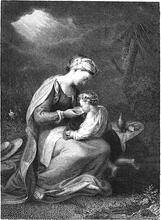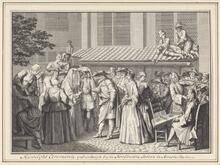The Jewish Family in Early Twentieth-Century United States
As countless poor young immigrant families arrived in the United States in the late nineteenth and early twentieth centuries, concerned social workers, rabbis, sisterhood presidents, and journalists sounded an alarm about the state of the Jewish family. Poverty, illegitimacy, and desertion were increasingly causes of concern. In response, philanthropists in the early twentieth century opened facilities for unwed mothers and to improve the behavior of the increasing number of “wayward” women, while efforts were made to combat the widespread phenomenon of desertion. In the interwar years, the modern Jewish woman stood accused of enfeebling Judaism by her inattention, neglect, and cultural illiteracy. Many Jewish women agreed that “the way to make the home Jewish is to make the mother Jewish” and participated in programs to enhance the Jewish home.
Introduction
“Happy [are] the children who live in the simple, practical atmosphere of the Jewish Home,” rhapsodized Esther Jane Ruskay in her 1902 paean to domestic Judaism, Hearth and Home Essays, in which she lavishly extolled the Jewish home’s “beautiful ceremonies, healthful restraints, and simple pleasures.” Thanks to those heymisch attributes, the American Jew lived a “temperate, well-ordered life, with none of the evils and none of the fears of this modern age to puzzle or to threaten him.” Sober, hard-working, and idealistic, the Jewish family, Ruskay proudly affirmed, furnished the background from which “every country in the world owes its best Jewish citizenship.”
Even as Ruskay penned her encomium to the Jewish family, that erstwhile object of public pride was rapidly becoming the subject of growing anxiety. As thousands of young immigrant families poured into America, swelling the ranks of the urban poor, a chorus of concerned social workers, rabbis, sisterhood presidents, and journalists collectively sounded an alarm. The fate of the Jewish family, they feared, hung in the balance. “One need but visit a few families to see that the word ‘home’ ... is but a mockery for the dirty, foul-smelling rooms in which our applicants are forced or choose to live,” observed a United Hebrew Charities worker early in the century, a sentiment echoed by the president of the National Conference of Jewish Charities. “The tenement is killing the Jewish home, of which we have all been proud,” he related. “It is separating families, driving the boys in the streets and the girls into the [dance] hall.” With inhospitable surroundings, economic uncertainty, and new social challenges, it was no wonder, observed Froyen Velt, a Yiddish women’s magazine of the prewar era, that the “foundation of happy family life, of sholem bayis, has been undermined.”
Illegitimacy and desertion, twin “blots on the eschutcheon of Judaism,” posed even greater threats to the family’s much-vaunted inviolability. At first, the Jewish community ignored the small but steadily growing number of unwed immigrant mothers; shame and social convention precluded public discussion, let alone intervention. It was “deemed inadvisable to mention it broadcast,” an eyewitness recalled many years later. “Remember this was before the days when sex problems, the social evil, and white slavery made parlor conversation and when the Jewish community objected to having its daughters spoken of as not virtuous.” Another added: “It is hard to realize what a bomb was exploded in the Jewish community when the Council wished to erect a home for unwed mothers. Intelligent Jewish men and women, prominent in philanthropy, were outraged that the virtue of Jewish girlhood and womanhood could be publicly assailed.”
Correcting “Wayward” Women
Eventually, such public resistance was overcome. In 1905, the National Council of Jewish Women, buoyed by the unstinting (although anonymous) financial support of the philanthropist Therese Schiff, succeeded in opening a tiny shelter for “wayward women” where, amid the splendid isolation of rural Staten Island, they could escape the “finger of scorn” of hostile neighbors and disgraced relatives. “We take by the hand the young first offender and first offender only, the victim of her own ignorance or stupidity or the machinations of vile men or women,” the Council explained. Six years later, as the number of unwed mothers continued to spiral upward, the women’s organization opened a much larger facility, known as the Lakeview Home, to accommodate as many as forty “erring sisters.”
Designed to resemble a private residence rather than a correctional facility, Lakeview sought to refashion the unwed mother into a self-supporting, independent, and genteel woman through an energetic program of vocational training and “ethical and moral reformation.” Unwed mothers, insisted Sadie American, one of Lakeview’s most stalwart supporters, are not “necessarily bad, fallen girls,” but girls who “simply haven’t had the opportunity to be good.” Lakeview provided that opportunity, training its young charges to be domestic servants, department store clerks, and “good housewives,” all the while holding out the possibility of marriage and the promise of respectability.
An apparent success, Lakeview came under the Jewish Board of Guardians’ supervision in the early 1920s and continued, well into the 1950s, to develop new strategies for coping with what Sara Edlin, its long-time director, called an “age-old problem.” “The attitude of society toward the unwed mother and her child has been persistently condemnatory,” Edlin wrote in The Unmarried Mother in Our Society, a 1954 account of her tenure at Lakeview. “If we no longer pin a scarlet letter on her, we nevertheless find other if more subtle ways of punishing her.”
Combatting Desertion
For many years, neither scarlet letters nor punishment awaited the many men who abandoned or deserted their wives in what became known as a “poor man’s divorce.” “My wife has been here for five years and I’ve wanted to leave her ten times,” an unhappy husband admitted. “She is a very undesirable woman. She often insults me in the presence of strangers.” Like illegitimacy, desertion darkened the prewar Jewish family’s good name, casting “discredit on our people’s reputation for domestic virtues.” Affecting the lives of ten to fifteen percent of Jewish women on relief in New York and Chicago in the early years of the century, the “desertion evil” provoked both moral outrage and concerted action.
Some Jewish communal institutions, such as the Jewish Daily Forward, sought to shame deserters into returning to their wives through its “Gallery of Missing Husbands.” Much like the rogues’ gallery developed by the police, this domestic Yiddish version contained the faces as well as brief biographies of husbands on the lam, hoping that alert readers would report their whereabouts to the authorities. The National Desertion Bureau went further still by taking systematic steps to apprehend deserters. Working in tandem with the courts and local government, it sought to compel the “errant husband” to support his family; failing that, he was encouraged to grant his wife a legal divorce. Between 1911, when the bureau was first established, and 1922, when social workers no longer considered desertion to be a serious problem, over twelve thousand cases, many of them including repeat offenders, came to its attention.
In accounting for the etiology of desertion, bureau workers identified as many as eighteen different factors, ranging from “money fever” and the interference of relatives to laziness and incompatibility. “Roundly speaking, economic pressure was the cause in about 30 percent of the cases, and self-indulgence the cause in about seventy percent,” explained Morris Waldman in an address before the Society of Jewish Social Workers. Elaborating, the veteran social worker pointed out that “the new environment affects the immigrant husband and wife differently; the former is more open to its influence and the gradual development of both along different lines naturally carries them further apart.”
Diagnosing the Problem in the Interwar Years
With growing acculturation and the “gradual development” of the entire immigrant Jewish community over time, the Jewish family continued to experience difficulties, except that the problems it now faced stemmed more from the consequences of affluence than the travails of immigration. Throughout the interwar years, the Jewish family appeared (once again) to be in crisis, alternately “languishing” or awaiting “disintegration.” “Those of us who still recall the Jewish family, its sense of kinship, its feeling of entity and oneness, are filled with a longing, with an overpowering nostalgia for the past,” wrote Conservative rabbi William Greenfield in 1940. “What has happened? Why has that unique tower of strength disappeared from our midst? Why has the home disintegrated before our eyes into a house rather than a home? Why has the family become an insignificant factor rather than the bulwark of strength that it once was?”
For many, the answers to these impassioned questions had nothing to do with demography, as one might expect, but with culture. To put it another way, the issue at hand was not so much the literal reproduction of the Jewish family as the social reproduction of yidishkayt, or Jewishness. With few exceptions, Jewish communal leaders of the interwar years did not voice much concern over intermarriage, which, they commonly believed, seldom took place. “A few anthropologists may believe the day will come when Americans will be as little opposed to mixed marriage as were medieval Baghdad and Toledo under the Saracens,” prophesied the Jewish Times in 1930. “But in the main there is little peril that Americans will take the slogan of the Melting Pot too literally. Historic, long-established integers will be preserved with little impairment, and America will be unified through means other than racial fusion.”
By the same token, a pattern of steadily declining fertility did not seem to imperil the health of the Jewish community. In this instance, as with intermarriage, hardly anyone voiced concern over the “dwindling” or “undersized” Jewish family. On the wane since the 1900s, the American Jewish birthrate remained consistently lower than that of other Americans. As early as 1905, native-born Rhode Island Jewish families, for example, had an average of 2.3 children, compared with 3.2 for native-born Catholic families and 2.5 for native-born Protestant ones, a pattern that persisted for decades. A 1941 study found that in Indianapolis the Jewish birthrate was twenty-five percent lower than that of Protestants. Ten years later, at the height of the postwar baby boom, studies in Detroit and Providence showed that while the birthrate in both cities tended to “skyrocket,” as historian Elaine Tyler May has put it, Jewish families, as a rule, tended to have only 2.3 children.
Despite these rather grim indices, few Jewish communal leaders paid attention, underscoring the extent to which cultural thresholds of alarm vary from generation to generation. Meanwhile, among those who did express concern, more was said about the immediate emotional and cultural drawbacks of small families than about the long-range statistical consequences of physical attrition. “A very small family is never a very interesting one,” Jacob Kohn observed, pointing out that A seven-day festival to commemorate the Exodus from Egypt (eight days outside Israel) beginning on the 15th day of the Hebrew month of Nissan. Also called the "Festival of Mazzot"; the "Festival of Spring"; Pesah.Passover “becomes rather pathetic when but two or three sit down to celebrate the Lit. "order." The regimen of rituals, songs and textual readings performed in a specific order on the first two nights (in Israel, on the first night) of Passover.seder. The festive meals and even family prayers lose much of their impressiveness and much of their significance as a social expression of religious life, if so few participate.”
If neither intermarriage nor fertility was perceived as problematic, what, then, ailed the Jewish family, inspiring the community’s moral authorities to liken it to an embattled fortress or a flimsy Maginot Line? Put simply, what ailed the Jewish family was its failure to act like one. Once a “domestic Temple,” the Jewish home “has become little more than a hotel,” complained one student of Jewish domestic mores in 1940. The Jewish home was now “a place to eat, a place to sleep, and a place from which to flee the moment that one has made use of its hotel functions,” a criticism that extended to its appearance as well. Devoid of Judaica and other tangible marks of Jewishness, the average middle-class Jewish home did not even look Jewish. The once-requisite print of Moses, Theodore Herzl, or the Vilna Head of the Torah academies of Sura and Pumbedita in 6th to 11th c. Babylonia.Gaon had given way to “copies of Van Goghs and Renoirs and the usual standard, highly impersonal ‘art’ of the department store,” while formerly cherished Lit. "sanctification." Prayer recited over a cup of wine at the onset of the Sabbath or Festival.Kiddush cups and Sabbath candlesticks had been banished to the attic or hidden inside an armoire.
More conspicuous still, or so it seemed to the community’s cultural arbiters, was the absence of Jewish ritual. “In the vast majority of American Jewish homes,” complained Newark rabbi Leon S. Lang, “Jewish living languishes progressively by default. In such homes it either disappears altogether or retains only a few vestigeal [sic] practices.” Statistical surveys of ritual behavior, conducted frequently and anxiously all throughout the interwar years by the Reform and Conservative movements, highlighted the degree to which modernity had imperiled domestic rituals or, at the very least, repositioned them. A 1931 study by the Union of American Hebrew Congregations of home rituals practiced by urban American Jews, for example, revealed that a striking sixty percent of respondents did not light Sabbath candles, while eighty percent eschewed the dietary laws altogether. What they now had, Lang observed in a 1939 address entitled “Our Changing Jewish Family,” are “families of Jews but not Jewish families.”
Blaming Women
Time and again, women were held accountable for this sorry state of affairs, accused of turning away from the obligations modern society had “deeded” to them. After all, in the modern, post-emancipation family, the Jewish woman’s responsibilities encompassed much more than the physical and emotional well-being of her children; the very future of Judaism weighed upon her shoulders. “It is woman alone who can make home life a Paradise for the Jew,” insisted Brooklyn rabbi Israel Levinthal. “She alone can save Judaism.” Many Jewish women were quick to agree. “The Jewish woman who presides over her home is entrusted with a great and noble responsibility,” stated Trude Weiss-Rosmarin. “The Jewish fate, past and present, and the Jewish future are in her keeping.”
All too often, though, these high-minded prescriptions seemed to be breached more than honored. “The great mass of our women—where are they, what has become of them,” the rabbis wondered. Some women, apparently, were out shopping on SabbathShabbat. Others preferred to spend their time reading Browning rather than the Bible, while still others knew much more about opera than cantorial music. Should you attend a Jewish women’s club meeting and ask those present to find a passage in Malachi, don’t be surprised if one of the women “ask[ed] whether Malachi was the title of an Italian opera,” witheringly observed a member of the National Council of Jewish Women.
The modern Jewish woman stood accused of enfeebling Judaism by her inattention, neglect, and cultural illiteracy. “Unless we constantly cultivate a Jewish spirit through an intelligent understanding of our religion, of our history, and of our philosophy, we will cease to be Jewesses through inclination and belief and remain Jewesses only through habit and external pressure,” Kate Aronson told an audience of attentive Jewish women.
In their campaign to educate Jewish women, some American Jewish leaders unhesitatingly recommended picking up a copy of Sir Walter Scott’s Ivanhoe, certain that the modern-day Jewess would be inspired and invigorated by Rebeccah’s flawless character and stalwart devotion to her people. “We need today women of Rebeccah’s type—women who should feel a close attachment to Israel,” said Rabbi Levinthal, referring to the biblical term for the Jewish people. Reading Ivanhoe was perhaps one way for the modern Jewish women to feel a sense of kinship with the Jewish people and its culture; others found guidebooks and manuals such as Deborah Melamed’s Three Pillars (1927) and Miriam Isaacs and Trude Weiss Rosmarin’s What Every Jewish Woman Should Know (1941) more helpful still. Manifestly concerned with defining and interpreting Jewish holiday and food customs in a sophisticated, twentieth-century idiom, these guidebooks were actually designed to engage the imagination and loyalty of those modern-day Jewish women who could “no longer be satisfied with dear old mother’s book of prayers.”
Whether consulting modern texts in the privacy of one’s home or joining together with the members of Ivriah, a New York City organization formed in 1926 to encourage the study of Hebrew and Jewish culture, Jewish women widely agreed that “the way to make the home Jewish is to make the mother Jewish.” The apparent zeal and enthusiasm that Ivriah women brought to their study sessions—these are “feminine Paul Reveres,” observed the American Hebrew, “knocking on the doors of New York, arousing the people to the urgent need to arm themselves spiritually”—was duplicated elsewhere throughout the country as Jewish women redoubled their efforts to achieve for American Judaism, sponsoring educational symposia in Nebraska and flocking to Bible class in Pennsylvania. “In a generation when women are with newly realized potentalities embarking upon careers as physicians, lawyers, journalists, and merchants,” remarked Stella Freiberg, a president of the National Federation of Temple Sisterhoods, “many hundreds of women have found joyous self-expression in a very old, yet new career—the profession of being a Jewess.”
Periodically, men were exhorted to assume or at least share some of the ritual responsibility for perpetuating Judaism lest it become thoroughly feminized. “If the concerns of Judaism and Jewish life are of little moment to the father, if the synagogue is only the goal of the mother’s pilgrimage and the father regularly keeps his distance, the son will draw the conclusion that religion in general and Judaism in particular are feminine accomplishments and Jewish life a feminine indulgence,” chided Jacob Kohn. While some fathers were no doubt inspired by Kohn’s rhetoric and the “new fatherhood” of the interwar years, which encouraged men to find meaning at home and in religion, still others were perfectly content with the domestic division of labor. “I never interfere in religious matters,” one such husband and father proudly informed Rabbi Kohn. “The religious training of my children is entirely in the hands of my wife.”
In some respects, little has changed since Esther Jane Ruskay took pen in hand over a century ago to celebrate the virtues of the Jewish family and to champion the intimate connection that exists between domesticity and Jewishness. Although attenuated, that intimate connection endures: flickering to life at a Passover seder or a Lit. "daughter of the commandment." A girl who has reached legal-religious maturity and is now obligated to fulfill the commandmentsbat mitzvah, Jewishness continues to rest in the family. In other respects, however, the contemporary Jewish family seems to be holding on for dear life. Beset by a staggeringly high number of intermarriages and by fundamental and far-reaching changes in the very definition of family, the Jewish home of today is more likely to inspire a requiem than an encomium of the kind Ruskay published. Still, if Jewish history teaches anything, it is that resilience and change, much like the bonds between family and Jewishness, go hand in hand.
Annual Report. Jewish Protectory and Aid Society (1919–1920).
Cohen, Steven M., and Paula E. Hyman, eds. The Jewish Family: Images and Reality (1986).
Edlin, Sara. The Unmarried Mother in Our Society (1954).
Joselit, Jenna Weissman. The Wonders of America: Reinventing Jewish Culture, 1880–1950 (1995).
Kohn, Jacob. Modern Problems of Jewish Parents: A Study in Parental Attitudes (1932).
Kraemer, David, ed. The Jewish Family: Myth and Metaphor (1989).
Ruskay, Esther Jane. Hearth and Home Essays (1902).
Yearbook. New York Section, National Council of Jewish Women (1903–1912).

